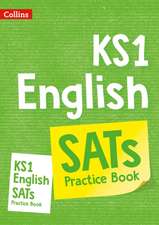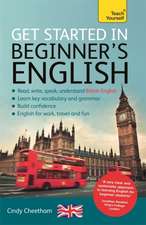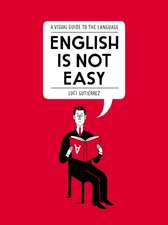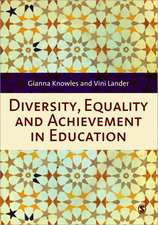Common Core for the Not-So-Common Learner, Grades K-5: English Language Arts Strategies
Autor Maria G. Dove, Andrea Honigsfelden Limba Engleză Paperback – 22 apr 2013
Preț: 239.02 lei
Nou
Puncte Express: 359
Preț estimativ în valută:
45.73€ • 47.76$ • 37.77£
45.73€ • 47.76$ • 37.77£
Carte tipărită la comandă
Livrare economică 15-29 aprilie
Preluare comenzi: 021 569.72.76
Specificații
ISBN-13: 9781452257822
ISBN-10: 1452257825
Pagini: 232
Dimensiuni: 178 x 254 x 18 mm
Greutate: 0.48 kg
Ediția:New.
Editura: SAGE Publications
Colecția Corwin
Locul publicării:Thousand Oaks, United States
ISBN-10: 1452257825
Pagini: 232
Dimensiuni: 178 x 254 x 18 mm
Greutate: 0.48 kg
Ediția:New.
Editura: SAGE Publications
Colecția Corwin
Locul publicării:Thousand Oaks, United States
Recenzii
"No stone was left unturned in this text. All the best researchers and practitioners are included in this clear, succinct guide which unpacks the Standards and gives outstanding suggestions for best literacy practice. Each anchor standard in all five domains is fully explained with practical, engaging activities that can add fun and learning to any classroom. Readers will feel supported and energized for the challenges ahead, with a toolkit for meeting the needs of all learners."
"Here's a resource that will make your teaching life easier and support those learners in your classroom who worry you the most. This book is full of great strategies based on research and aligned with the Common Core. Strategies at your fingertips to provide you with less stress and worry, plus you will have students who are meeting with success."
"This book provides timely, practical assistance for addressing the needs of our unique learners during this time of rigorous standards-based instruction. One can use these samples and ideas immediately in his/her K-5 classroom!"
"Here's a book that can help teachers and administrators alike to meet the pressing need we all have to increase our repertoire of practical, research-supported strategies, if we are to enable all learners to meet the challenging requirements embedded in the new Common Core Standards. Dove and Honigsfeld's book is timely and immensely user friendly. We will absolutely not be able to "do" the Common Core on our own; Common Core for the Not-So-Common Learner, Grades K-5 will serve us well as a partner in enhancing our professional practice in ways that will support all of our students, not just those who have been targeted as high needs."
"Andrea and Maria have the unique gift of interpreting the research and translating into action for teachers. In this book, they outline in easy to understand language the instructional practices teachers need to engage in when implementing the Common Core with the 'not so common learners'. They have taken Collaboration to a new level of understanding for teachers who teach the 'not so common learner' and who want to take their English Learners to high levels of critical thinking and language development in the implementation of the Common Core."
"The strength of this book is in its organization. It not only addresses the key shifts of the Common Core State Standards for English Language Arts and Literacy, but is organized to the level of the anchor standards, which are further broken down into strand-specific sets. It doesn’t just talk about the Standards, but rather offers essential solutions to K-5 teachers on how to achieve them with diverse learners. Finally, a how-to book that is worth its weight in gold!"
"Though this book focuses on implementing the CORE standards with diverse learners, it really extends beyond to promote a schoolwide 'growth mindset' for an inclusive and collaborative service delivery model - a model which sees ELLs and other at-risk learners for what they can do with instructional support. This is a very practical handbook for elementary teachers and schools."
"If you want to know how to help the diverse learners in your classroom meet the Common Core Standards, Common Core for the Not-So-Common Learner is a must-read book."
"Here's a resource that will make your teaching life easier and support those learners in your classroom who worry you the most. This book is full of great strategies based on research and aligned with the Common Core. Strategies at your fingertips to provide you with less stress and worry, plus you will have students who are meeting with success."
"This book provides timely, practical assistance for addressing the needs of our unique learners during this time of rigorous standards-based instruction. One can use these samples and ideas immediately in his/her K-5 classroom!"
"Here's a book that can help teachers and administrators alike to meet the pressing need we all have to increase our repertoire of practical, research-supported strategies, if we are to enable all learners to meet the challenging requirements embedded in the new Common Core Standards. Dove and Honigsfeld's book is timely and immensely user friendly. We will absolutely not be able to "do" the Common Core on our own; Common Core for the Not-So-Common Learner, Grades K-5 will serve us well as a partner in enhancing our professional practice in ways that will support all of our students, not just those who have been targeted as high needs."
"Andrea and Maria have the unique gift of interpreting the research and translating into action for teachers. In this book, they outline in easy to understand language the instructional practices teachers need to engage in when implementing the Common Core with the 'not so common learners'. They have taken Collaboration to a new level of understanding for teachers who teach the 'not so common learner' and who want to take their English Learners to high levels of critical thinking and language development in the implementation of the Common Core."
"The strength of this book is in its organization. It not only addresses the key shifts of the Common Core State Standards for English Language Arts and Literacy, but is organized to the level of the anchor standards, which are further broken down into strand-specific sets. It doesn’t just talk about the Standards, but rather offers essential solutions to K-5 teachers on how to achieve them with diverse learners. Finally, a how-to book that is worth its weight in gold!"
"Though this book focuses on implementing the CORE standards with diverse learners, it really extends beyond to promote a schoolwide 'growth mindset' for an inclusive and collaborative service delivery model - a model which sees ELLs and other at-risk learners for what they can do with instructional support. This is a very practical handbook for elementary teachers and schools."
"If you want to know how to help the diverse learners in your classroom meet the Common Core Standards, Common Core for the Not-So-Common Learner is a must-read book."
Cuprins
Preface
Acknowledgments
About the Authors
1. Introduction
Who Are Our Not So Common Learners?
The Standards Movement
Common Core Advances
Application of the Common Core to Address Individual Differences
Student Diversity and Teacher Challenges
What Is Not Covered in the Common Core Document
Focus on Research-Based Strategies to Address Learning Needs
2. Strategies for Academic Language Development
Why Diverse Learners Need Explicit Instruction in Academic Language?
Core Language and Vocabulary Strategies
Vocabulary Acquisition and Use
Knowledge and Application of Language
Conventions of Standard English
Anticipated Outcomes
Instructional Challenges
Promising Classroom Practices
Common Core Standards—(Un)Common Reflection Questions
Key Resources
3. Reading Strategies for Literature
Why Teaching Diverse Learners Reading Strategies Promotes Comprehension of Literary Texts
Core Reading Strategies
Key Ideas and Details
Craft and Structure
Integration of Knowledge and Ideas
Range of Reading and Level of Text Complexity
Anticipated Outcomes
Instructional Challenges
Promising Classroom Practices
Common Core Standards—(Un)Common Reflection Questions
Key Resources
4. Reading Strategies for Informational Texts
Why Teaching Diverse Learners Reading Strategies Promotes Comprehension of Informational Texts
Core Reading Strategies
Key Ideas and Details
Craft and Structure
Integration of Knowledge and Ideas
Range of Reading and Level of Text Complexity
Anticipated Outcomes
Instructional Challenges
Promising Classroom Practices
Common Core Standards—(Un)Common Reflection Questions
Key Resources
5. Reading Foundational Skills
Why Explicit Instruction in Basic Literacy Skills is Necessary?
Core Reading Strategies
Print Concepts
Phonological Awareness
Phonics and Word Recognition
Fluency
Anticipated Outcomes
Instructional Challenges
Promising Classroom Practices
Common Core Standards—(Un)Common Reflection Questions
Key Resources
6. Writing Strategies
Why Explicit Strategy Instruction Improves the Writing of Diverse Learners
Core Writing Strategies
Text Types and Purposes
Production and Distribution of Writing
Research to Build and Present Knowledge
Range of Writing
Anticipated Outcomes
Instructional Challenges
Promising Classroom Practices
Common Core Standards—(Un)Common Reflection Questions
Key Resources
7. Speaking and Listening Strategies
Why Speaking and Listening Skills Improve the Overall Academic
Development of Diverse Learners
Core Speaking and Listening Strategies
Comprehension and Collaboration
Presentation of Knowledge and Ideas
Anticipated Outcomes
Instructional Challenges
Promising Classroom Practices
Common Core Standards—(Un)Common Reflection Questions
Key Resources
8. Key to Successful Implementation: Collaborative Strategies
Why Collaborative Practices Help Meet the Common Core
Core Collaborative Strategies
Instructional
Curriculum Mapping and Alignment
Joint Instructional Planning
Parallel Teaching
Co-developing Instructional Materials
Collaborative Assessment
Co-teaching
Noninstructional
Joint Professional Development
Teacher Research
Joint Parent-Teacher Conferences and Report Card Writing
Planning, Facilitating, and Participating in Extracurricular Activities
Anticipated Outcomes
Challenges
Common Core Collaborations—(Un)Common Reflection Questions
Key Resources
References
Index
Acknowledgments
About the Authors
1. Introduction
Who Are Our Not So Common Learners?
The Standards Movement
Common Core Advances
Application of the Common Core to Address Individual Differences
Student Diversity and Teacher Challenges
What Is Not Covered in the Common Core Document
Focus on Research-Based Strategies to Address Learning Needs
2. Strategies for Academic Language Development
Why Diverse Learners Need Explicit Instruction in Academic Language?
Core Language and Vocabulary Strategies
Vocabulary Acquisition and Use
Knowledge and Application of Language
Conventions of Standard English
Anticipated Outcomes
Instructional Challenges
Promising Classroom Practices
Common Core Standards—(Un)Common Reflection Questions
Key Resources
3. Reading Strategies for Literature
Why Teaching Diverse Learners Reading Strategies Promotes Comprehension of Literary Texts
Core Reading Strategies
Key Ideas and Details
Craft and Structure
Integration of Knowledge and Ideas
Range of Reading and Level of Text Complexity
Anticipated Outcomes
Instructional Challenges
Promising Classroom Practices
Common Core Standards—(Un)Common Reflection Questions
Key Resources
4. Reading Strategies for Informational Texts
Why Teaching Diverse Learners Reading Strategies Promotes Comprehension of Informational Texts
Core Reading Strategies
Key Ideas and Details
Craft and Structure
Integration of Knowledge and Ideas
Range of Reading and Level of Text Complexity
Anticipated Outcomes
Instructional Challenges
Promising Classroom Practices
Common Core Standards—(Un)Common Reflection Questions
Key Resources
5. Reading Foundational Skills
Why Explicit Instruction in Basic Literacy Skills is Necessary?
Core Reading Strategies
Print Concepts
Phonological Awareness
Phonics and Word Recognition
Fluency
Anticipated Outcomes
Instructional Challenges
Promising Classroom Practices
Common Core Standards—(Un)Common Reflection Questions
Key Resources
6. Writing Strategies
Why Explicit Strategy Instruction Improves the Writing of Diverse Learners
Core Writing Strategies
Text Types and Purposes
Production and Distribution of Writing
Research to Build and Present Knowledge
Range of Writing
Anticipated Outcomes
Instructional Challenges
Promising Classroom Practices
Common Core Standards—(Un)Common Reflection Questions
Key Resources
7. Speaking and Listening Strategies
Why Speaking and Listening Skills Improve the Overall Academic
Development of Diverse Learners
Core Speaking and Listening Strategies
Comprehension and Collaboration
Presentation of Knowledge and Ideas
Anticipated Outcomes
Instructional Challenges
Promising Classroom Practices
Common Core Standards—(Un)Common Reflection Questions
Key Resources
8. Key to Successful Implementation: Collaborative Strategies
Why Collaborative Practices Help Meet the Common Core
Core Collaborative Strategies
Instructional
Curriculum Mapping and Alignment
Joint Instructional Planning
Parallel Teaching
Co-developing Instructional Materials
Collaborative Assessment
Co-teaching
Noninstructional
Joint Professional Development
Teacher Research
Joint Parent-Teacher Conferences and Report Card Writing
Planning, Facilitating, and Participating in Extracurricular Activities
Anticipated Outcomes
Challenges
Common Core Collaborations—(Un)Common Reflection Questions
Key Resources
References
Index
Notă biografică
Descriere
The strategies you need to teach common standards to diverse learners
Realistic and thorough, this teacher-friendly book shows how to help every student, including English Learners, students with disabilities, speakers of nonstandard English, and other struggling learners, meet the Common Core Standards for English Language Arts (ELA). This resource:
Realistic and thorough, this teacher-friendly book shows how to help every student, including English Learners, students with disabilities, speakers of nonstandard English, and other struggling learners, meet the Common Core Standards for English Language Arts (ELA). This resource:
- Familiarizes readers with each of the Common Core's 32 anchor standards for ELA
- Outlines the specific skills students need to fulfill each standard
- Presents a wealth of flexible teaching strategies and tools that build those skills
- Includes guidance on professional collaboration and co-teaching









